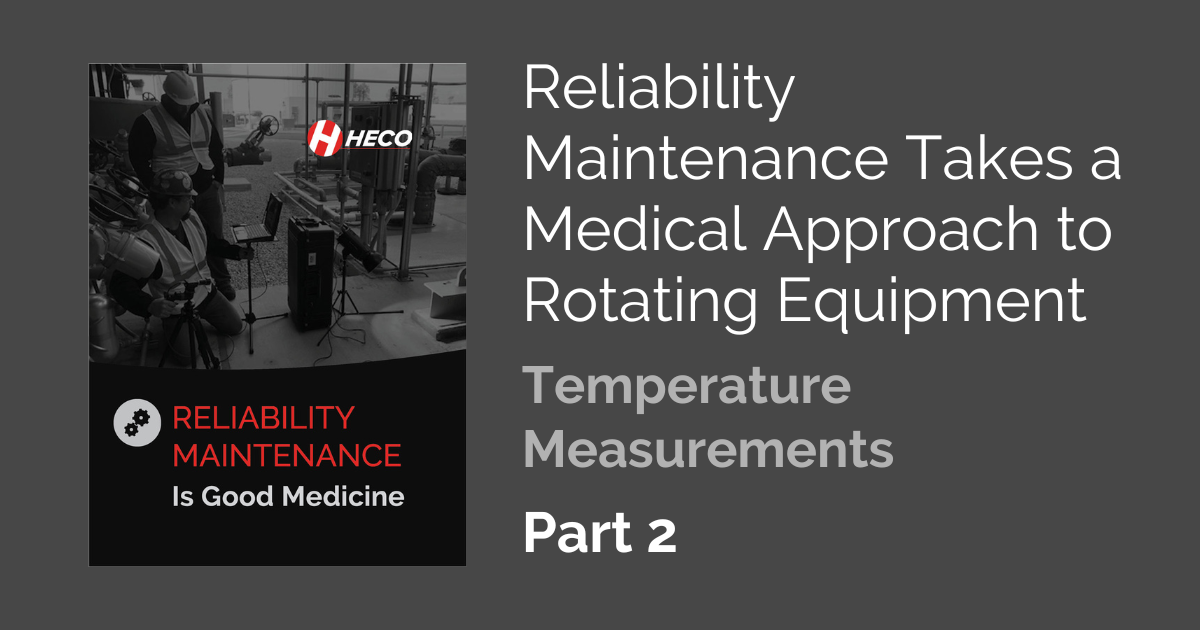Reliability Maintenance Takes a Medical Approach to Rotating Equipment, Part 2 – Temperature Measurements - HECO
August 24, 2023
What was the first thing your parents did when you complained that you didn’t feel well before school? We’re guessing it was checking for a fever by touching your forehead with the back of their hand before grabbing a thermometer for a more exact measurement.
In reliability maintenance, temperature is an equally important indication that there may be internal issues within rotating equipment. This is one of many ways that caring for electric motors and systems shares similarities with the field of medicine to ensure uptime or system wellness.
At HECO, we know rotating equipment but we rely on something a bit more sophisticated – and safer – than our hands to evaluate electric motor systems for increased temperatures.
Methods of Measurement
Anatomically speaking, body temperature measurements were one of the first medical diagnostic tests used since elevated body temperature serves as a primary indicator of infection.
Methods of taking one’s temperature have become more precise and comfortable for the patient thanks to the replacement of mercury-based thermometers that had to be inserted in the body with digital counterparts and readily available infrared technology that does not require bodily contact.
Recently, medicine has adopted the use of thermal scans (thermography) to help diagnose specific diseases such as breast cancer.
Likewise, the measurement of temperatures in and around industrial equipment is a technology that has been used for a long time and can help identify problems before an equipment failure.
Why Temperature Matters
There are a number of reasons that rotating equipment could be running at higher temperatures. Increased heat readings are especially critical within bearings, lubricants, and windings to avoid overheating and damage to the equipment.
For example, elevated bearing temperature is a strong indicator of damage to the bearings or poor lubrication while higher-than-normal temperatures in electrical circuits can indicate imminent failure.
The use of thermal cameras allows technicians to utilize the field of thermography to identify and diagnose problems sooner. Early detection is important to prevent increased motor temperatures from causing increased resistance within the rotating equipment as well as decreased torque and voltage.
Acceptable temperature ranges within given machine components should be discussed with your equipment supplier and are often referenced in instruction manuals and the motor’s nameplate.
A further consideration is the ambient temperature around your rotating equipment. Operating in a confined, unventilated space can cause a system’s temperature to increase and cause internal issues. Consult your equipment supplier or manufacturer for ideal internal and external operating conditions.
All Systems Go
Monitoring the health of your electric motor systems doesn’t require a medical degree. In fact, with help from HECO, you can leave the testing and diagnostics to our team of experts.
We have the experience you need to attain a clean bill of health and implement a holistic reliability maintenance program going forward.
Contact us to discuss what ails your rotating equipment so we can prescribe the remedy.
To date, the Reliability Maintenance Takes a Medical Approach to Rotating Equipment series includes:
Part 1 – A Prescription for Healthy Systems.
Part 2 – Temperature Measurements.
Future posts in the series will include:
Part 3 – Ultrasonic Testing.
Part 4 – Vibration Analysis & EKGs.
Part 5 – Oil Testing & Bloodwork.
Part 6 – Modal Analysis & EMGs.
Part 7 – Crossovers & Similarities.
Posted in Predictive
